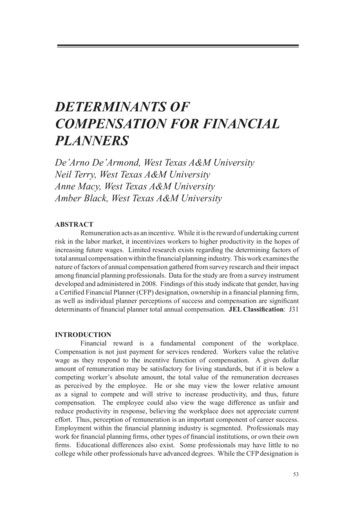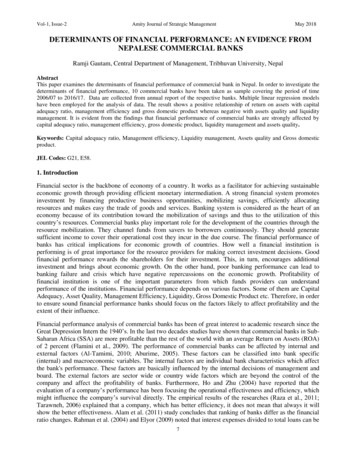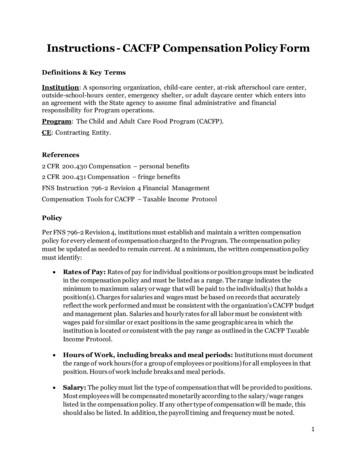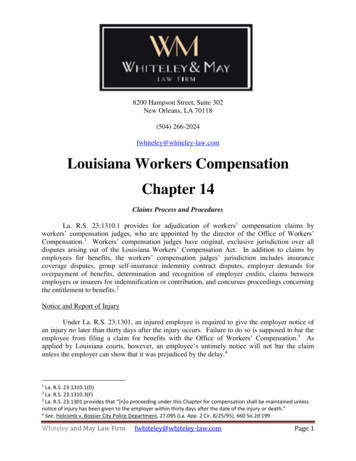
Transcription
DETERMINANTS OFCOMPENSATION FOR FINANCIALPLANNERSDe’Arno De’Armond, West Texas A&M UniversityNeil Terry, West Texas A&M UniversityAnne Macy, West Texas A&M UniversityAmber Black, West Texas A&M UniversityABSTRACTRemuneration acts as an incentive. While it is the reward of undertaking currentrisk in the labor market, it incentivizes workers to higher productivity in the hopes ofincreasing future wages. Limited research exists regarding the determining factors oftotal annual compensation within the financial planning industry. This work examines thenature of factors of annual compensation gathered from survey research and their impactamong financial planning professionals. Data for the study are from a survey instrumentdeveloped and administered in 2008. Findings of this study indicate that gender, havinga Certified Financial Planner (CFP) designation, ownership in a financial planning firm,as well as individual planner perceptions of success and compensation are significantdeterminants of financial planner total annual compensation. JEL Classification: J31INTRODUCTIONFinancial reward is a fundamental component of the workplace.Compensation is not just payment for services rendered. Workers value the relativewage as they respond to the incentive function of compensation. A given dollaramount of remuneration may be satisfactory for living standards, but if it is below acompeting worker’s absolute amount, the total value of the remuneration decreasesas perceived by the employee. He or she may view the lower relative amountas a signal to compete and will strive to increase productivity, and thus, futurecompensation. The employee could also view the wage difference as unfair andreduce productivity in response, believing the workplace does not appreciate currenteffort. Thus, perception of remuneration is an important component of career success.Employment within the financial planning industry is segmented. Professionals maywork for financial planning firms, other types of financial institutions, or own their ownfirms. Educational differences also exist. Some professionals may have little to nocollege while other professionals have advanced degrees. While the CFP designation is53
increasing in importance, it is not required to practice. Additionally, the CFP designationmay not have much value for employees within large financial institutions who do notneed an external verification quality. The fractured employment situation obfuscatesthe assessment of determinants of financial planner total annual compensation.The existing empirical research investigating remuneration withinfinancial planning is limited, has been open to definitional interpretation,and is without empirical regard. This empirical research is among the firstto examine the importance of key determinant and their respective impact ontotal annual compensation of the individuals working as financial planners.The organization of this study is divided into four sections. The firstsection provides an overview and background of the literature relevant to thestudy. The second section offers a discussion of the data and methodologyutilized to conduct the study. The next section offers a discussion of theempirical results. The final section puts forth a summary and conclusion.BACKGROUNDSocial psychologist Fritz Heider developed attribution theory, a cognitivetheory associated with success and interpersonal relationships.Attributiontheory explores individual awareness of cause and effect scenarios and howthe outcomes of such scenarios affect the individual’s perception of usefulness.Heider proposed that people endeavor for prediction and understanding of dailyevents in order to give their lives stability and predictability (Heider, 1958).Fullin and Mills (1995) apply attribution theory to sports, analyzing howathletes adjust performance output to awareness of cause and effect scenarios. Externalattribution assigns causality to an outside factor, such as to pay or promotion as in thisstudy, or to competition in the sports analogy. Internal attribution assigns causalityto factors such as independence or ability. Financial planners engage attributiontheory when measuring and comparing themselves to others. After comparison, theindividual may attribute the differences to internal or external deficiencies, to whichthe individual can adjust. Athletes can adjust ability, effort, and tasks. Like a footballquarterback, the financial planner moderates the plays of financial life around the keyplanning areas, making strategic adjustments (Mittra, Potts, and LaBrecque, 2005).General Career Success DimensionsWhile defining career success can be nebulous, individuals with careerand professional aspirations have an interest in the contributors to success andcompensation (Hall, 1976, 2002). Hughes (1937, 1958) divided career successinto objective and subjective characteristics. Objective elements are observable,measurable, and verifiable by a third party. Examples include pay, promotion, status,rank and affiliation. Subjective elements are an individual’s responses to experienceswithin the career path. Examples include work/life balance, sense of meaning andpurpose within the profession, personal growth, creativity, variety, and independence.While objective criteria has dominated much of the overall career successliterature, studies involving subjective criteria have increased as more peopleadopt and customize the criteria within career research. Heslin (2005) argues fourinherent assumptions are prevalent in the current career success literature. First,objective outcomes (pay and/or promotions) stand as a measure of career success.54
Second, job and career satisfaction provide reactive stimuli to individuals’ chosencareer paths. Third, people, in general, exhibit the same level of concern aboutsuccess achieved by objective criteria; yet, do not exhibit the same level of concernregarding the subjective criteria. Fourth, a presumption exists that people evaluatetheir respective success relative to self-referent criteria and career aspirations.Compensation and Perceptions of Success within Financial PlanningEarly financial planning success studies focused more on objective elements,while research that is more recent includes subjective elements. In a study of 275practicing CFP-designated professionals, Van Auken, Hira, and Norris (1989) find thatCFPs working in larger population centers, offering a larger selection of products andservices, and using a commission-based fee structure exhibit higher income levels.Gresham and Cooper (2001) suggest a grading system for assessing success with themain components of additional assets, referral business, and new business. The plannerevaluates his or her success in the components versus client goals and expectations.Levin (2001) includes subjective elements, measuring the successof financial planning against a client’s long-term life plan. If wealth ofclient is a measure of success, Levin integrates all aspects of a client’sresources with a focus on the financial, emotional, physical, and spiritual.The Financial Planning Association 2001 compensation and staffing studyfinds that personnel management in financial advisory firms in the United Statesdramatically affects the success of the financial planning firm. The study revealsthe importance of human resource factors in compensation, especially competitivepay (Tibergien & Palaveev, 2001). Peatey (2007) reiterates the importanceof quality service and thus, quality of staff for success in financial planning.Veres (2002, 2003) discusses the importance of time and time managementas two of the most important components of financial planner success. Scholp (2004)examines career success planning by merging the objective criteria of monetarygain and recognition with subjective criteria such as work/life balance. Vance(2004) finds that trust building with the client and giving back to the community areimportant components to success. Evensky (2005) evaluates changes to the financialplanning industry over the prior two decades. Instead of success measured by theplanner’s ability to outperform benchmarks, Evensky states that clients will judgefuture success by how well the planner meets the client’s long-term planning goals.Vessenes (2005) provides practice analysis with a quiz that planners can selfadminister to see where they measure relative to peers defined as superstars or toplanners commanding a gross annual income of one million dollars or more and servingan average of 350 clients. Success is with not just more clients, but closing more deals.The College for Financial Planning’s Survey of Trends (2007) found higherrates of CFP certification and job satisfaction among financial planners. Financialplanners credited their communication and people skills, referrals, and the CFPdesignation as major factors affecting their individual success (O’Brien, 2007).Mahli (2005) relates success for independent planners to the basic marketingconcepts of referrals, targeted emails and mailing campaigns, public relationsinitiatives, community functions, benchmarking data, and best practice profiles.Hayden (2006) promotes creating customer loyalty and thus, renewalincome, as a measure of success. A planner can create loyalty through repetitionof quality service combined with high ethical standards. Drozdeck (2005) notes55
the importance of increased proficiency in financial and psychological profilingand practice management while improving professional knowledge as fundamentalto a successful practice. Gagne (2005) opines that understanding clients, obtaininga field of specialization, and maintaining currency in the field are essential tosuccess. Gunz and Heslin (2005) present a search of practitioner literature ingeneral terms yields literally thousands of manuscripts about career success.While subjective elements are more prevalent in the research, basicsuccess measurement is still objective, whether it is total pay, yearly additionalpay, or total asset base. The subjective elements, broadly combined into clientsatisfaction, influence planner success through increased business and referralsbut also internal elements of job satisfaction. A fundamental aspect of internal jobsatisfaction is relative value added to clients and not just absolute remuneration.DATA AND METHODOLOGYThe data utilized within this study were gathered via a survey instrumentdeveloped and administered in an online format in 2008. Contact procedures forthis Web survey followed a modified Dillman e-mail methodology consisting of prenotice, survey invitation, thank you message, and reminder e-mails (Dillman, 2000).Participation in the survey was voluntary and participants had the option to withdrawat any time without penalty. Respondents choosing to participate in the survey weredirected to a secure third-party instrument. The Web survey link ensures all respondentdata were collected via two-way secure socket layer (SSL3) security protocols. At notime did the researchers have access to any identifying or highly sensitive respondentinformation in conjunction with the survey instrument. A total of 403 respondents(4% response rate) who are members of the FPA (Financial Planning Association)and agree to receive email from the organization answered the survey. This result isstatistically representative of the FPA membership with a 5% margin of error at a 95%confidence interval. The final sample used, after significant non-response cases wereeliminated, was 349 respondents (3.5%). All representative data were to reflect theinformation given by respondents practicing financial services consistent with the sixstep financial planning process. Of those 403 respondents, 23 cases were deleted asrespondents reported job or FPA membership tasks not related to the financial planningprocess. Further, of the remaining 380 respondent cases, 31 additional significant nonresponse cases were eliminated, providing 349 respondent cases for the final dataset.The instrument utilized within this study comprised of 47 questions, rangingfrom demographic and compensation information to more qualitative data based onthe preference for numerical information as in work from Viswanathan (1993) to needfor emotion data based on the work of Raman, Chattopadhyay, and Hoyer (1995). Theinstrument was pilot tested by a group of 14 individuals two weeks prior to survey launch. Thepurpose of this pilot test was to ensure the instrument functioned properly via the Internet.The explicit empirical model employed to investigate the determinants ofannual compensation for financial planners is specified as follows in equation 1:(1) COMPi B0 B1 PSUCCESSi B2 PCOMPi B3 EDUCi B4 CFPi B5OWNERi B6 SMALLi B7 FEMALEi B8 MINORITYi ui.Table 1 presents summary statistics for model variables. The dependent56
variable COMP measures the annual compensation of financial planners participatingin the survey. The average compensation level of the survey cohort is 155,000per year, which includes a minimum of 42,000 and a maximum of 635,000. Theperceived level of success variable (PSUCCESS) measures the degree to which aperson believes they have achieved success subject to a Likert scale ranging from alow of 1 to a high of 5. People that perceive themselves as successful are expectedto earn higher annual compensation. The second dependent variable in the model(PCOMP) measures the cohort perception of the total annual compensation a successfulfinancial planner should earn. The PCOMP variable for the survey cohort averages 207,000 per year. The expectation is for perceived compensation associated withbeing a successful financial planner to have a positive correlation with actual annualcompensation. The EDUC variable measures the numbers of years of education posthigh school achieved by financial planners in the survey cohort. The EDUC variabledefines an associate degree as two years, bachelor degree as four years, masterdegree as six years, and doctorate degree as nine years of education. The averageeducation in the sample is 4.92, which indicates that most survey respondents achieveat least a baccalaureate degree and a significant number pursue professional degrees.The last five dependent variables in the model are categorical variables. TheCFP variable captures the number of financial planners earning the Certified FinancialPlanner designation. Eighty-one percent of the survey cohort hold the CFP designation.The expectation is that earning the CFP designation will have a positive impact on annualcompensation of financial planners. The OWNER variable measures the percent offinancial planners that are owners or partners in a financial planning firm. The expectationis that financial planners that are owners will receive higher annual compensation. Fiftyeight percent of the survey cohort own or are partners in a financial planning firm. Themodel defines small firms (SMALL) as a company employing less than five financialplanners. Twenty-eight percent of the financial planners in the survey work for a smallfirm. Finally, thirty percent of the financial planners in the study are female (FEMALE)and six percent are ethnic minorities (MINORITY). The expectation for the variablesSMALL, FEMALE, and MINORITY are for all to have a negative impact on annualcompensation given the hypothesis that small firms tend to manage fewer portfolios andfemales and minorities face some degree of customer discrimination within the profession.RESULTSTable 2 presents the estimated empirical relationship between the explanatoryvariables and annual compensation of financial planners. The ordinary least squares(OLS) model explains over 68 percent of the variance in annual compensation offinancial planners. A model with logarithmic transformations of the dependentvariable was considered but was not substantially different from the parsimoniousOLS model. The alternate specification raised the R-square to over 70 percentbut did not fundamentally change the significance or relative magnitude of anyof the independent variables. All of the independent variables have a correlationless than .70, implying excessive multicollinearity is not a concern for the modelspecification. Five of the eight variables in the model are statistically significant.The first two variables in the model are PCOMP and PSUCCESS, whichmeasure the impact of perception as a factor that influences annual compensationlevel of financial planners, holding other variables constant. Both variables are have57
a positive coefficient and are highly significant. Total annual compensation onethinks a successful financial planner should earn (PCOMP) is positive and is the moststatistically significant variable within the regression model (t 8.794, p .01). Themean value of reported total annual compensation is approximately 155,000, whilethe mean value of what the respondent thinks a successful financial planner shouldearn annually is approximately 207,000. The gap between actual compensationand the amount identified as successful implies the typical financial planner doesnot view him or herself as a success. Nevertheless, the model includes a variablemeasuring perceived level of personal success (PSUCCESS), which has a positive andstatistically significant impact on compensation (t 8.54, p .01). It is interestingto note financial planners appear to correlate perceived level of success to annualcompensation, despite the observation that most financial planners believe successrequires a compensation level that is significantly greater than their current level.It appears individuals who perceive themselves as moderately successful have notreached what they consider their full earnings potential. One possible interpretationis that the field of financial planning attracts goal-oriented individuals that seekcontinued financial improvement for their client, which normally yields higherearnings for the financial planner since most obtain part of their compensation frompercentage-based asset management. This desire for continued improvement mightlead to a gap between current compensation and the compensation level required toachieve self-perceived personal success. Heider (1958) observes individuals “strivefor prediction and understanding of daily events in order to give their lives stabilityand predictability.” For financial planners, it is possible striving for the next level ofcompensation provides stability and predictability within their own lives. Consistentwith success literature, the financial planner strives to attain maximum growthpotential regarding decisions made on a client-by-client portfolio basis (Leyes, 2006).The empirical model also includes the human capital variables measuringamount of college education obtained (EDUC) and earning a CFP designation.Surprisingly, the education variable has a negative coefficient. The result impliesthat higher levels of formal education have a negative impact on compensation.The empirical results imply every year of education lowers financial planner annualcompensation by 4,850. The anomaly of a negative coefficient on the EDUCvariable is somewhat mitigated by the fact that the variable is not statisticallysignificant and the CFP human capital variable has a positive coefficient and ishighly significant. For the individual who completes the CFP designation, thereturn with respect to compensation is approximately 29,850. The combinedresults indicate the return to financial planners from formal training toward earningthe CFP designation is much greater than seeking advanced college training.Survey results indicate that owning or being a partner of a financial planningfirm has a positive and statistically significant impact on compensation. The OWNERcoefficient implies being an owner or partner adds approximately 29,000 in additionalcompensation for financial planners, holding all other factors in the model constant. Incontrast, a financial planner working for a small firm of five or fewer planners will tend toearn less annual compensation relative to working for a large firm, although the result isnot statistically significant. Holding other factors constant, compensation from workingfor a small firm is approximately 11,000 a year less than working for a larger firm. Oneexplanation for the result is that smaller firms are more likely to have problems achievingeconomies of scale with respect to marketing, information, and other support services.58
The last two variables in the model are the demographic variables FEMALEand MINORITY. Empirical results from the model indicate the FEMALE variablehas a negative and statistically coefficient. Specifically, female financial planners earnapproximately 17,000 less than their male counterparts. Although changing, mendominate the financial planning industry by a rate exceeding two to one. The maledomination of the profession appears to impact compensation by gender. One possibleexplanation is that customer discrimination is the sources of the male compensationpremium, assuming a large percentage of wealthy clients prefer to have a male serve astheir financial planner. Another possible explanation is that a woman moving into thefinancial planning industry is a relatively new phenomenon, and the average experienceof the male professionals is significantly greater. A limitation of the model is that itdoes not control for professional experience. MINORITY is the final variable in themodel, which has a positive coefficient in magnitude of approximately 8,000 per yearassociated with the attribute. The survey cohort characterized as an ethnic minorityis only six percent. Despite the modest number of minorities in the sample, minorityfinancial planners earn a small premium, although the result is not statistically significant.CONCLUSIONThis study investigates the determinants of annual compensation forfinancial planners. The research sample consists of 349 financial plannersresponding to an online survey sent to the membership of the Financial PlanningAssociation in 2007. Perception of personal success, perception of the total annualcompensation a successful financial planner should earn, holding the designationof being a Certified Financial Planner (CFP), and being an owner or partner ofa financial firm are positive and statistically significant determinants of annualcompensation of financial planners. The positive and significant variables leadto an overall conclusion that a positive perception of success, high expectationsrelating to financial success, professional certification, and a willingness to be aleader via owner or partnership are keys to financial success in the financial planningindustry. The CFP designation and ownership traits are of particular importance,which are both associated with close to 30,000 a year in additional compensation.The only variable with a negative and statistically significant result relates tothe trait of being female. Holding other factors such as education and CFP designationconstant, the trait of being a woman is associated with a compensation penalty ofapproximately 17,000 per year. The male compensation premium might provideevidence for the existence of customer discrimination in the financial planning industry.Alternatively, the model does not control for years of professional experience, whichmight also explain the male compensation premium. Working for a small financialplanning firm, amount of college education, and minority classification are not statisticallysignificant determinants of financial planner compensation for the survey cohort.Avenues for future related research include investigating the preferencefor numerical information and need for emotion within financial planning, financialplanner behavior impact on success in financial planning, customer selection ofa financial planner, and customer perceptions of a successful financial planner.59
REFERENCESCollege for Financial Planning. (2007). 2007 Survey of Trends in FinancialPlanning. Greenwood Village, CO.Dillman, D .A. (2000). Mail and Internet Surveys: The Tailored Design Method.2nd. Ed. John Wiley and Sons, Inc. NY.Drozdeck, S. (2005). Tips from the Top. Advisor Today, 100(5), 44-50.Evensky, H. (2005). The Future Ain’t What it Used to be. Journal of FinancialService Professionals, 59(1), 16-18.Fullin, C., & Mills, B. D. (1995). Attribution Theory in Sport: Problems andSolutions (Report No. SP036085). East Lansing, MI: National ResearchCenter for Research on Teacher Learning. (ERIC Document ReproductionService No. ED387439).Gagne, G. B. (2005). Five Habits for Success. Advisor Today, 100(10), 24.Gresham, S. D., & Cooper, E. (2001). Measure Your Success. Financial Planning,31(7), 93.Gunz, H. P., & Heslin, P. A. (2005). Reconceptualizing Career Success. Journal ofOrganizational Behavior, 26(2), 105-111.Hall, D. T. (1976). Careers In Organizations. Glenview, IL: Scott, Foresman.Hall, D. T. (2002). Careers In and Out of Organizations. Thousand Oaks, CA: Sage.Hayden, V. C. (2006). A Planner’s Pyramid of Success: Logistics. Journal ofFinancial Planning, 19(11), 40-43.Heider, F. (1958). The Psychology of Interpersonal Relations. New York: JohnWiley & Sons.Heslin, P. A. (2003). Self –and other-Referent Criteria of Career Success. Journal ofCareer Assessment, 11, 262-86.Heslin, P. A. (2005). Conceptualizing and Evaluating Career Success. Journal ofOrganizational Behavior, 26, 113-136.Hughes, E. C. (1937). Institutional Office and the Person. American Journal ofSociology, 43, 404-13.Hughes, E. C. (1958). Men and Their Work. Glencoe: Free Press.Levin, R. (2001). How Success is Measured. Financial Planning, 31(1), 92.Mahli, P. (2005). Secrets of Independent Planner’s Success. Financial Planning,35(4), 21.Mittra, S., Potts, T., & LaBrecque, L. (2005). Practicing Financial Planning forProfessionals. Rochester, MI: R.H. Publishing.O’Brien, E. (2007). Success Peaks Along with Longevity. Financial Planning,37(5), 27.Peatey, G. (2007). Maintaining Your Most Valuable Asset. Money Management,21(42), 22.Raman, N. V., Chattopadhyay, P., & Hoyer, W. D. (1995). Do Consumers SeekEmotional Situations: The Need for Emotions Scale. Advances inConsumer Research. Association for Consumer Research. 22, 537-42.Provo, UT.Scholp, A. J. (2004). Balanced Success. Advisor Today, 99(5), 80.Tibergien, M, & Palaveev, P. (2001). Study Shows Staffing is Key to PracticeSuccess. Journal of Financial Planning, 14(7), 44-47.Van Auken, H. E., Hira, T. K., & Norris, D. M. (1989). Study Examines Factors60
Influencing Success in Financial Planning. Journal of Financial Planning,2(1), 37-44.Vance, C. (2004,). Vance’s Recipe for Success. Advisor Today, 99(7), 46.Veres, B. (2002). The Eternal Determinants of Success. Journal of FinancialPlanning, 15(3), 24-26.Veres, B. (2003). Planners Progress: Through the Jungle and Over the Gorge.Journal of Financial Planning, 16(1), 30-33.Vessenes, K. (2005). Million Dollar Method. Financial Planning, 35(3), 90-91.Viswanathan, M. (1993). Measurement of Individual Differences in Preference forNumerical Information. Journal of Applied Psychology, 78(5), 741-52.61
62
variable COMP measures the annual compensation of financial planners participating in the survey. The average compensation level of the survey cohort is 155,000 per year, which includes a minimum of 42,000 and a maximum of 635,000. The perceived level of success variable (PSUCCESS) measures the degree to which a










